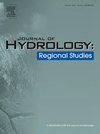基于实测和水力模拟的朗萨河河口曼宁粗糙度系数时空变化
IF 5
2区 地球科学
Q1 WATER RESOURCES
引用次数: 0
摘要
langsa市是印度尼西亚沿海地区之一,由于潮汐流和季节性降雨,容易发生洪水。本研究旨在利用曼宁分布排列法动态确定潮流和上游流量的曼宁粗糙度系数(n)。利用HEC-RAS 1D水力模型,结合枯水季和雨季的水位数据,预测潮汐河流的洪水水位。该模型根据宽度与深度(W/D)比在四个位置进行统计校准,以确保准确性。河段划分为宽浅(W/D <; 10)和窄深(W/D <; 10)。研究表明,曼宁系数需要根据河段的比例进行调整,特别是宽度与深度之比小于10的河段。在潮汐河流中,曼宁系数发生了动态变化,特别是在上游汛期;在低潮过渡至涨潮时,n值增大至0.090,上游汛期n值减小至0.055。此外,雨季上游流量增加29.35 %,突出了当地水文对环境变化的敏感性。这些发现支持沿海地区潮汐河流早期预警系统的发展,从而加强洪水管理和减灾战略。本文章由计算机程序翻译,如有差异,请以英文原文为准。
Spatiotemporal variations of Manning’s roughness coefficient in the estuary of Langsa River based on field measurements and hydraulic modeling
Study region
Langsa City is one of Indonesia's coastal areas prone to flooding due to tidal flows and seasonal rainfall.
Study focus
This study aims to determine the Manning roughness coefficient (n) dynamically using the Manning distribution permutation method for tidal flow and upstream discharge. A HEC-RAS 1D hydraulic model is used to predict flood levels by combining water level data in the dry season and rainy season in tidal rivers. The model is calibrated statistically at four locations based on the width-to-depth (W/D) ratio to ensure accuracy. River segments are classified as wide-SHALLOW if W/D > 10 and narrow-DEEP if W/D < 10.
New hydrological insights for the region
The study reveals that the Manning coefficient needs to be adjusted according to the ratio of river segments, especially those with a width-to-depth ratio of less than 10. Dynamic changes in the Manning coefficient are observed in tidal rivers, especially during upstream flood periods; the n value increases to 0.090 during low flow conditions, transitioning to high tide, and decreases to 0.055 during the flood period in the upper reaches. Additionally, a 29.35 % increase in upstream discharge during the rainy season highlights the sensitivity of local hydrographs to environmental changes. These findings support the development of early warning systems for tidal rivers in coastal areas, thereby strengthening flood management and mitigation strategies.
求助全文
通过发布文献求助,成功后即可免费获取论文全文。
去求助
来源期刊

Journal of Hydrology-Regional Studies
Earth and Planetary Sciences-Earth and Planetary Sciences (miscellaneous)
CiteScore
6.70
自引率
8.50%
发文量
284
审稿时长
60 days
期刊介绍:
Journal of Hydrology: Regional Studies publishes original research papers enhancing the science of hydrology and aiming at region-specific problems, past and future conditions, analysis, review and solutions. The journal particularly welcomes research papers that deliver new insights into region-specific hydrological processes and responses to changing conditions, as well as contributions that incorporate interdisciplinarity and translational science.
 求助内容:
求助内容: 应助结果提醒方式:
应助结果提醒方式:


